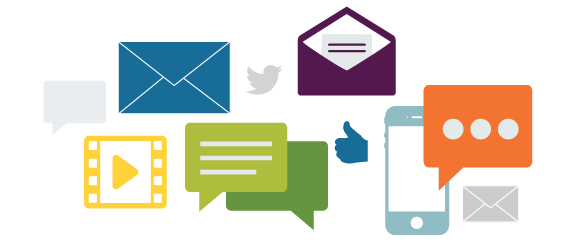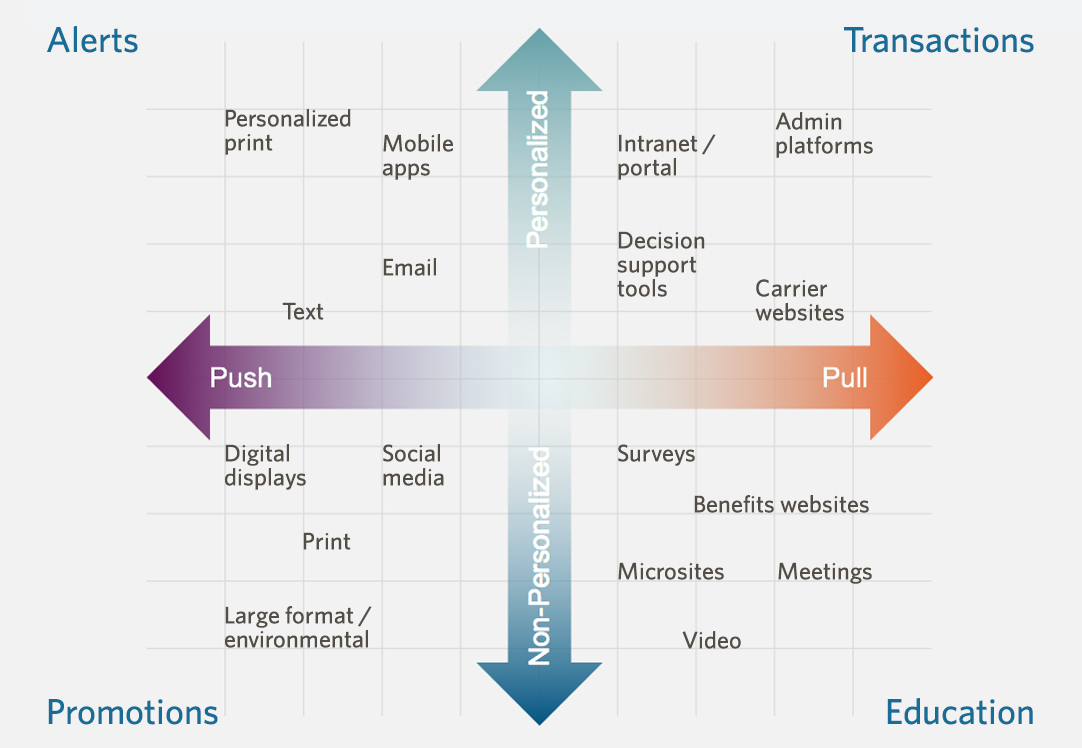
Is adopting a new benefits communication channel a good idea?

Looking for additional ways to communicate with your employees? Before you roll out video, a blog, text messaging, or any other new communication channel, plan for how it will fit into your overall communication ecosystem. A good place to start is by answering these questions:
- Will it replace or duplicate another channel?
- How will it complement—and integrate with—other channels?
- How will you promote this new channel so that employees know when to use it?
- How will you support this channel over time?
The most successful communication strategies leverage the strengths of multiple channels. As you think about each channel in your mix, ask yourself “What is channel X’s job?” For example, what is the job of a postcard in a campaign? What should it accomplish, how should it accomplish it, etc.? When you’re intentional about how you’re using media, you’ll drive better results.
Some channels “push” employees to take action. Others are resources that employees “pull” from to get just-in-time information that can help them answer questions or make decisions. The diagram below segments channel types into quadrants, depending on their natural strengths. As you review your current ecosystem and think about adding a new channel to the mix, note how the channels are best used and consider the following options.

Alerts
Alerts work best when they are personalized, targeted, and timely for your target audience. They should inspire action and have metrics in place to track their effectiveness.
- How will a new channel’s alerts compete with existing alert channels?
- Does the channel allow employees to manage their alert preferences, so they can turn them off, or opt out of receiving them?
Mobile solutions are often a great way to get alert-type messaging to your audiences. And you can use other channels in this quadrant for singular calls to action. In addition, consider breaking up your communications for these types of messages. For example, instead of sending one email with 12 separate calls to action, develop an email series that you send over a period of weeks or months. Each email can then focus on a singular call to action.
Transactions
Channels that fall into this category are often the backbone to any communication strategy. With mountains of personal data at their disposal, they excel at personalized communication. When leveraged successfully, these channels create a compelling, targeted, and personalized experience.
- Have we created an integrated, seamless experience for using the platforms of our program administrators, or is the experience disjointed? (For example, is single sign-on in place, or will employees need to log in to each platform separately?)
- How many hand-offs are there to get tasks accomplished? For instance, if an employee performs the necessary steps to earn a wellness credit discount on his medical premiums, does he need to go to three different websites and enter the same information? Or is a system in place that stores, shares, and pre-populates information, and connects program administrators?
- How does this channel support a personalized experience for my target audiences? Can I tailor messages and the experience based on factors such as full time versus part time, benefit plan participation status, and other data points, to create unique experiences for my audiences?
Promotions
Promotions can be effective channels for your “hard-to-reach” audiences. For them, try messaging that's specific to an environment or location to build ambient awareness or promote short-term initiatives or events.
Messaging in unconventional and unexpected ways and locations is another way of catching people’s eyes.
- What channels might be available to you that you haven’t already thought about?
- What unexpected photos, headlines, and physical locations might you use to get people’s attention?
Education
If you’re like most employers, this is where you spend the bulk of your time, energy, and resources when it comes to communicating benefits. You explain how things work, and are building channels that provide helpful information so employees have 24/7 self-service access.
That’s why it’s so important to have a centralized communication resource—your benefits website—that helps connect all the dots for your employees and their families. The best hubs also triage content, allowing people to find answers quickly based on their specific information need.
- Is your benefits website set up to triage information so that employees can find quick answers, and then drill down for details if and when they want to?
- How are you measuring the effectiveness of your educational efforts?
Technology is constantly changing, and salespeople can be very compelling. Before you move forward and make any significant changes to your communication ecosystem—including adding a new channel—take a step back. First, evaluate all the different channels you’re using today. Then, develop a strategy to maximize the value of each channel to be sure you’re getting the biggest bang for your buck. Use our cheat sheet below to help, as you consider your goals, audience, and budget.

Need a hand? Let us know. We’re happy to help.
Work with Us
We partner with organizations that value their people first. Let’s talk.

Jon Stuckey, VP Creative Technology and Innovation, provides strategic vision, guidance, and solutions for our largest clients.
